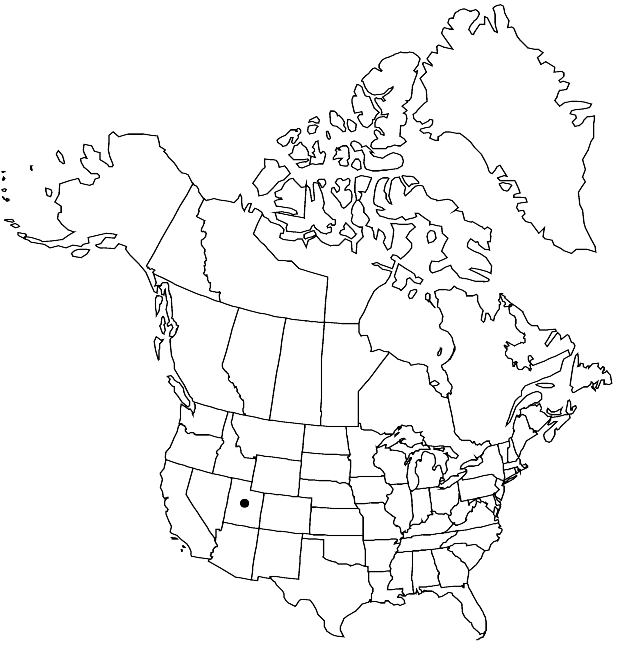Difference between revisions of "Draba ramulosa"
Contr. Gray Herb. 214: 6. 1984.
FNA>Volume Importer |
imported>Volume Importer |
||
| (3 intermediate revisions by 2 users not shown) | |||
| Line 6: | Line 6: | ||
|place=214: 6. 1984 | |place=214: 6. 1984 | ||
|year=1984 | |year=1984 | ||
| + | }} | ||
| + | |special_status={{Treatment/ID/Special_status | ||
| + | |code=E | ||
| + | |label=Endemic | ||
| + | }}{{Treatment/ID/Special_status | ||
| + | |code=C | ||
| + | |label=Conservation concern | ||
}} | }} | ||
|basionyms= | |basionyms= | ||
| Line 33: | Line 40: | ||
-->{{#Taxon: | -->{{#Taxon: | ||
name=Draba ramulosa | name=Draba ramulosa | ||
| − | |||
|authority=Rollins | |authority=Rollins | ||
|rank=species | |rank=species | ||
| Line 47: | Line 53: | ||
|publication title=Contr. Gray Herb. | |publication title=Contr. Gray Herb. | ||
|publication year=1984 | |publication year=1984 | ||
| − | |special status= | + | |special status=Endemic;Conservation concern |
| − | |source xml=https:// | + | |source xml=https://bitbucket.org/aafc-mbb/fna-data-curation/src/2e0870ddd59836b60bcf96646a41e87ea5a5943a/coarse_grained_fna_xml/V7/V7_456.xml |
|tribe=Brassicaceae tribe Arabideae | |tribe=Brassicaceae tribe Arabideae | ||
|genus=Draba | |genus=Draba | ||
Latest revision as of 22:33, 5 November 2020
Perennials; (loosely matted, grayish); caudex branched (with persistent leaf bases, branches creeping, sometimes terminating in sterile rosettes); not scapose. Stems unbranched, 0.4–0.6 dm, densely pubescent throughout, trichomes dendritic, 3–6-rayed, (often crisped), 0.1–0.4 mm. Basal leaves (imbricate); not rosulate; sessile; blade obovate to oblanceolate, 0.4–1.1 cm × 2–3.2 mm, margins entire, (base and margins not ciliate), surfaces pubescent with stalked, 4–8-rayed trichomes, 0.1–0.5 mm, (sometimes 1 or more rays spurred), adaxially sometimes trichomes simple. Cauline leaves 2 or 3 (sometimes basal leaves spaced, flowering stem appearing to 8-leaved); sessile; blade oblong to ovate, margins entire, surfaces pubescent as basal. Racemes 4–15-flowered, ebracteate or proximalmost 1 or 2 flowers bracteate, slightly elongated in fruit; rachis not flexuous, pubescent as stem. Fruiting pedicels divaricate-ascending, usually straight, rarely curved upward, 3–6(–10) mm, pubescent, trichomes 3–6-rayed, (crisped, 0.1–0.4 mm), and, sometimes, simple. Flowers: sepals broadly ovate, 1.7–2.4 mm, pubescent, (trichomes short-stalked, 2–5-rayed); petals yellow, obovate to oblanceolate, 3–4.5 × 1.5–2.5 mm; anthers ovate, 0.4–0.5 mm. Fruits (not appressed to rachis), ovate to elliptic, plane, flattened, 4–6.5 × 2.5–4 mm; valves densely pubescent, trichomes simple and short-stalked, 2–5-rayed, 0.08–0.35 mm; ovules 6–12 per ovary; style (0.1–)0.3–0.7 mm. Seeds oblong, 1.4–1.8 × 0.8–1.2 mm.
Phenology: Flowering Jun–Aug.
Habitat: Rock outcrops, talus, gravelly soils
Elevation: 3300-3600 m
Discussion
Of conservation concern.
Molecular and chromosomal data (M. D. Windham, unpubl.) strongly suggest that Draba ramulosa is an allopolyploid species. It is thought to have originated through hybridization between D. sobolifera and a member of the white-flowered, euploid lineage of M. A. Beilstein and M. D. Windham (2003). It is easily distinguished from D. sobolifera by having pale yellow to whitish (versus bright yellow) petals, grayish (versus green) foliage, non-ciliate (versus ciliate) basal leaves pubescent with 4–8-rayed (versus 2–4-rayed) trichomes, often proximally bracteate (versus ebracteate) racemes, and flattened (versus inflated basally) fruits. Draba ramulosa is known from the Tushar Mountains in south-central Utah (Beaver and Piute counties).
Selected References
None.
